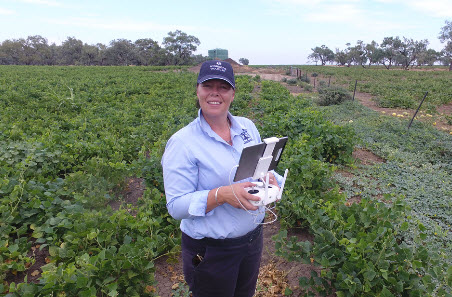How to find the right drone
16 March 2017

“Do your homework – identify the purpose of the drone and select the best model to suit. Buying the wrong one can be both expensive and disappointing.”
That’s the advice from Brooke Sauer, who oversees the purchase of drones for farming in her role as Digital Agriculture Manager with McGregor Gourlay Agricultural Services.
Not all drones are created equal and there is considerable variation in features and performance between high-quality brands and cheap models, according to Brooke.
“In our service area across northern NSW and south-west Queensland, we’re seeing more drones being used for an ever-increasing range of purposes, including live telemetry to enhance agronomy services, photography, assesing crop and pasture variability, mapping plant health, monitoring water flow for irrigation, checking water troughs and mustering livestock,” she said.
“However, it is important to avoid getting caught up in the hype.”
Choose wisely
Brooke said every brand has limitations, so producers need to consider carefully what capabilities they require, e.g. length of battery life and flight time, video quality, positioning ability for hovering, collision avoidance, telemetry ability and flight autonomy.
“There are plenty of inexpensive models of drones available both in stores and online, but I would not recommend shopping on price alone,” she said.
“Cheaper drones are often more difficult to control, have a smaller range, don’t have their own GPS, lack positioning ability (they can’t hover) and are less stable in flight, particularly in windier weather.”
After sales support
Brooke said hardware glitches were relatively common, so good after-sales support was a must.
“About 20% of the drones we sell are crashed and returned for repairs, which reinforces the advantage of buying a known brand from a reputable supplier,” she said.
For those wanting to start with an entry level drone for photography and/or to move livestock, Brooke recommends a quadcopter under 2kg.
“This class of drone does not require an operator’s certificate as long as it is flown on the producer’s own land and within visual range,” she said.
“It’s easy to fly, and can stop and hover.”
For involved tasks, such as mapping pastures, Brooke recommends a fixed-wing drone that can be mounted with a quality sensor and requires more training to fly.
Data drain
“Producers need to be mindful that if they are collecting data, quality sensors are more expensive and need to be supported by a good internet package with high download speeds and plenty of data,” Brooke said.
“Information generated from 40ha will use about 1 gigabyte to upload and then 250 megabytes to download, and it can take up to 24 hours for all of this to happen.”
Once a drone model has been selected, Brooke said there was a world of apps available. Some of the most common are Litchi (photography, video), DroneDeploy (maps, measurement) and Pix 4d (drone mapping software).
“Within the confines of CASA regulations, the only limitation with the use of drones is our own imagination,” Brooke said.
Depending on the drone selected, producers can expect to pay anywhere from $900 for a basic model (supplied by a reputable manufacturer) that takes photographs, to $3,500 for a drone with up to 28 minutes’ flight time, collision avoidance, active tracking (can follow a moving object), live telemetry to an iPad and autonomous flight.
“Generally, more expensive drones are more stable, easier to fly and have longer range,” she said.
More information
Brooke Sauer
E: sauerb@mcgregorgourlay.com.au
See MLA’s drone feature on pages 14-19 of the February/March 2017 edition of Feedback


